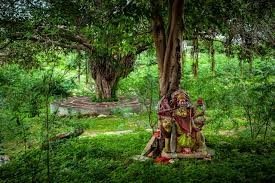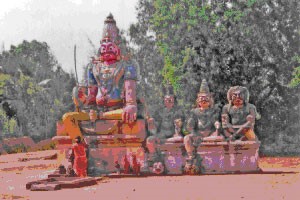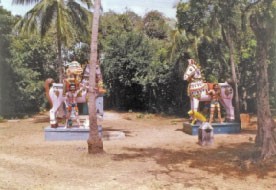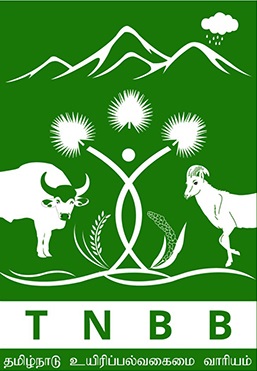SACRED GROVES OF TAMILNADU
SACRED GROVES OF TAMILNADU
Tamil Nadu Forest Department with the assistance of the C.P.R. Environmental Education Centre, Chennai have carried out survey of Sacred Groves in Tamil Nadu during 2011. The survey listed about 1262 Sacred Groves in Tamil Nadu. Many of the Sacred Groves are reservoirs of rare fauna and flora especially those located within Protected and Notified areas. They are protected under Tamil Nadu Forest Act 1882 and Wildlife Protection Act 1972. Forest Department had identified various threats to Sacred Groves in Tamil Nadu. Human activities such as dead wood collection, biomass gathering, lopping of tender branches and green leaves for goats, creation of footpaths, cattle grazing, mining of sand and clay for brick-making and collection of wild fruits and vegetables and also collection of plant parts for medicinal uses are affecting the ecology of the Sacred Groves. In addition, invasion of exotic weeds has become a serious problem in the ecology of some Sacred Groves. The domination of alien species such as Eupatorium odoratum, Lantana camara, Prosopis juliflora and Hyptis suaveolens often threatens and depletes the local species. Conflicts among the Sacred Grove managers have also resulted in the loss of biodiversity in certain Sacred Groves.

India is among the world’s top 17 mega-diverse countries, with a rich variety of biological communities, which include coral reefs, Alpine meadows, rainforests, and desert scrub. In India, as elsewhere in many other parts of the world, a number of communities worship different forms of nature. One of the significant outcomes of the interaction of people with nature is the extraordinary reverence towards landscape in general and nature in particular. Central among them are the sacred groves, dedicated to local deities and/or ancestral spirits. Thousands of these groves have been documented as storehouses of remarkable biodiversity, repositories of unique and rare plants and home to myriad birds, reptiles and other animal species. Sacred groves probably represent the single most important ecological tradition of ancient Indian culture.
Tamil literature describes a scenario where people were seen as one of the components of five different ecosystems. Each ecosystem had people carrying out their unique habits of hunting, gathering, cultivating and worshipping deities. It appears that the ancient deities of Tamilnadu are no other than the deities presently worshipped in villages under different names. Although some of the deities may not be associated with extensive forest cover, most are found intimately connected with at least a small grove of plants. These are the sacred groves dedicated to local deities or ancestral spirits. Most are linked to reservoirs, ponds, springs or streams and many are located in catchments near the origins of springs or streams.
Tamil literature pertaining to the Sangam period (300 BC – 200 AD) describes a scenario where people were seen as one of the components of five different ecosystems that is the term “thinai”, which is the classification of the geographical landscape, its ecological and traditional perspectives, and the social and moral behavior of the people of each region. These regions are Kurinji (mountainous region), mullai (forest tracks), marutham (agricultural lands), neithal (coastal regions) and paalai (wastelands). Each thinai is associated with its own characteristic flowers, trees, animals, birds, climate and other geographical features (Dayanandan, 1973). Each ecosystem had people carrying out their unique habits of hunting, gathering, cultivating and worshipping deities. It appears that the ancient deities of Tamilnadu are the present deities worshipped in the villages under different names (Amirthalingam, 1998). Although some of the deities may not be associated with extensive forest cover, most are found in intimate association with at least a small grove of plants. These are the sacred groves. Each grove has a residing deity and folklore associated with either the deity or the grove.
Each eco-zone had people practising their customary activities like hunting, gathering, cultivating and worshipping deities. The goddess Kotraivai also called as Kotri was living in the forest in the midst of devils. There is reference to this in Sangam literature like Kalithogai. In the Tamil epic Silappadikaram we come to know that the Chola port city of Poompuhar had a number of groves like ilavandigai-solai, sampaathi-vanam, kaveri-vanam and saaya-vanam within which the palaces and temples were located. Even today, there are sacred places near Poompuhar like Tiruvenkadu, Talachankadu, Perumthottam, etc. The Pattinappaalai describes the land and the people of the seaport of Poompuhar. Similar depictions are also available regarding the other great cities like Madurai, Vanji, Kanchi and sacred temple towns like Srirangam.
Sacred groves probably represent the single most ecological tradition of ancient Tamil culture. Each grove is dedicated to the local folk deities and spirits (vanadevathai) and has folklore associated with either the deity or the grove. Commonly found deities are the Aiyanar, Sastha, Muniyappa, Karuppuswami, Veeran (Kaaval Teivam / Protective Deity), Andavar (a powerful wish-fulfilling deity) and the goddesses are Selliyamman, Kali, Ellaikali, Ellaipidari, Sapta Kannis, Pechiyamman, Rakkachiyamman and Nagadevadhai (fertility and good health). Among these, Aiyanar is the most ubiquitously found deity. The annual festival is celebrated in all the groves of all districts and is marked by community offerings of pongal and animal sacrifice. Sacrifices of fowl, goat and sheep are made to all the deities except Aiyanar. In certain sacred groves, people fulfill their vows by tonsuring (shaving the head to make a ceremonial offering of hair to the god). Terracotta horses of various sizes are lined up in front of the deity within the sacred groves. The people pray for a good harvest.
The concept of sacred groves is very ancient and was once prevalent in most parts of the world. Sacred groves are part of the rich heritage of India, and play an important role in the religious and socio-cultural life of the local people. Over 14000 sacred groves have been reported so far in different parts of India. The sacred groves are the home of the local flora and fauna and represent a mini-biosphere reserve, making them an essential part of the conservation process. Due to the prevalent belief system, human interference in the sacred groves has been restricted and thereby there is a reduction of harvesting of natural resources. The consequence of such restriction has been that sacred groves have evolved as important reservoirs of biological diversity. Many sacred groves constitute pristine vegetation, and are particularly rich in climax vegetation and associate groups of organisms like flora and fauna.. Murugesan, Amirthalingam. (2012). Sacred Groves of Tamil Nadu and their Management. India is among the world’s top 17 mega-diverse countries, with a rich variety of biological communities, which include coral reefs, Alpine meadows, rainforests, and desert scrub. In India, as elsewhere in many other parts of the world, a number of communities worship different forms of nature. One of the significant outcomes of the interaction of people with nature is the extraordinary reverence towards landscape in general and nature in particular.
Central among them are the sacred groves, dedicated to local deities and/or ancestral spirits. Thousands of these groves have been documented as storehouses of remarkable biodiversity, repositories of unique and rare plants and home to myriad birds, reptiles and other animal species. Sacred groves probably represent the single most important ecological tradition of ancient Indian culture.
Tamil literature describes a scenario where people were seen as one of the components of five different ecosystems. Each ecosystem had people carrying out their unique habits of hunting, gathering, cultivating and worshipping deities. It appears that the ancient deities of Tamilnadu are no other than the deities presently worshipped in villages under different names. Although some of the deities may not be associated with extensive forest cover, most are found intimately connected with at least a small grove of plants. These are the sacred groves dedicated to local deities or ancestral spirits. Most are linked to reservoirs, ponds, springs or streams and many are located in catchments near the origins of springs or streams.
Tamil literature pertaining to the Sangam period (300 BC – 200 AD) describes a scenario where people were seen as one of the components of five different ecosystems that is the term “thinai”, which is the classification of the geographical landscape, its ecological and traditional perspectives, and the social and moral behavior of the people of each region. These regions are Kurinji (mountainous region), mullai (forest tracks), marutham (agricultural lands), neithal (coastal regions) and paalai (wastelands). Each thinai is associated with its own characteristic flowers, trees, animals, birds, climate and other geographical features (Dayanandan, 1973). Each ecosystem had people carrying out their unique habits of hunting, gathering, cultivating and worshipping deities. It appears that the ancient deities of Tamilnadu are the present deities worshipped in the villages under different names (Amirthalingam, 1998). Although some of the deities may not be associated with extensive forest cover, most are found in intimate association with at least a small grove of plants. These are the sacred groves. Each grove has a residing deity and folklore associated with either the deity or the grove.
Each eco-zone had people practising their customary activities like hunting, gathering, cultivating and worshipping deities. The goddess Kotraivai also called as Kotri was living in the forest in the midst of devils. There is reference to this in Sangam literature like Kalithogai. In the Tamil epic Silappadikaram we come to know that the Chola port city of Poompuhar had a number of groves like ilavandigai-solai, sampaathi-vanam, kaveri-vanam and saaya-vanam within which the palaces and temples were located. Even today, there are sacred places near Poompuhar like Tiruvenkadu, Talachankadu, Perumthottam, etc. The Pattinappaalai describes the land and the people of the seaport of Poompuhar. Similar depictions are also available regarding the other great cities like Madurai, Vanji, Kanchi and sacred temple towns like Srirangam.
Sacred groves probably represent the single most ecological tradition of ancient Tamil culture. Each grove is dedicated to the local folk deities and spirits (vanadevathai) and has folklore associated with either the deity or the grove. Commonly found deities are the Aiyanar, Sastha, Muniyappa, Karuppuswami, Veeran (Kaaval Teivam / Protective Deity), Andavar (a powerful wish-fulfilling deity) and the goddesses are Selliyamman, Kali, Ellaikali, Ellaipidari, Sapta Kannis, Pechiyamman, Rakkachiyamman and Nagadevadhai (fertility and good health). Among these, Aiyanar is the most ubiquitously found deity. The annual festival is celebrated in all the groves of all districts and is marked by community offerings of pongal and animal sacrifice. Sacrifices of fowl, goat and sheep are made to all the deities except Aiyanar. In certain sacred groves, people fulfill their vows by tonsuring (shaving the head to make a ceremonial offering of hair to the god). Terracotta horses of various sizes are lined up in front of the deity within the sacred groves. The people pray for a good harvest.
The concept of sacred groves is very ancient and was once prevalent in most parts of the world. Sacred groves are part of the rich heritage of India, and play an important role in the religious and socio-cultural life of the local people. Over 14000 sacred groves have been reported so far in different parts of India. The sacred groves are the home of the local flora and fauna and represent a mini-biosphere reserve, making them an essential part of the conservation process. Due to the prevalent belief system, human interference in the sacred groves has been restricted and thereby there is a reduction of harvesting of natural resources. The consequence of such restriction has been that sacred groves have evolved as important reservoirs of biological diversity. Many sacred groves constitute pristine vegetation, and are particularly rich in climax vegetation and associate groups of organisms like flora and fauna.

























